There are plenty of opinions about the Great Resignation and whether it will come to fruition in Australia. To ascertain what’s really happening, HRM unpacks some of the facts and figures.
Employers have been told to brace for a massive surge in resignations this year. Experts who fall into the ‘Great Resignation is coming’ camp say Australia will follow in the footsteps of the United States and the United Kingdom – both countries have already experienced significant employee turnover.
Those on the opposing side, however, argue that while Australia might see some employee turnover that’s higher than usual, the threat of the Great Resignation as a monumental disruption to the labour market has been overstated and oversimplified.
As opinions abound, HRM returns to the basics: what evidence is there to support the prospect of the Great Resignation? And what can we deduce from the data to determine whether the Great Resignation will hit our shores?
To get into the nuts and bolts of what we could expect this year, HRM has collected six charts and asked Robin Boomer, Director of Advisory at Gartner, for his analysis on the current data.
Australia’s falling resignation rate
Over the last few decades, Australia’s resignation rate has been steadily declining.
In the year leading up to February 2021, the proportion of employed Australians changing jobs reached an all time low of 7.6 per cent, according to the Australian Bureau of Statistics.
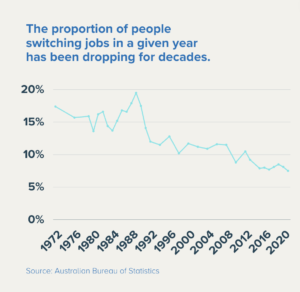
Boomer says there are a few factors to explain this phenomenon.
“Stability has always been something that the Australian labour market has placed a high premium on. People look for jobs they can keep for a while, they look for careers and they value staying with the same organisation for a while,” says Boomer.
“There’s also been a decline in participation in organised labour as well. I think that’s linked to people having less power to take their talent where it’s going to be best for them. So there’s a tendency for people to stay with jobs even though that might not be the best situation for them over time.”
The pandemic has drastically changed the status quo of the labour market, according to Boomer.
“People are reevaluating the place that work has in their lives and demanding more from employers. We have to recognise that work and life are not two different things to balance, but that work is a part of life,” says Boomer.
“At the moment, many people are looking to other parts of life [outside of work] to carry more of the load, whether that’s more time with family, personal development pursuits, or an avocation rather than a career.”
This reevaluation has led many employees to contemplate alternative work, resulting in the anticipated Great Resignation that could come to the fore early this year.
How does the US compare?
In 2021, the Great Resignation was already in full swing in the United States, and some experts have predicted employee turnover will be just as great in Australia.
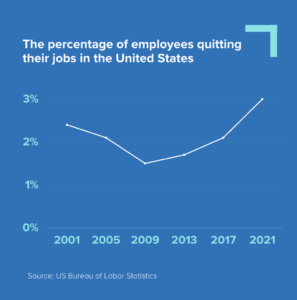
However, Boomer thinks the comparison between the US and Australia is misguided.
“There are very different labour market dynamics and worker conditions here in Australia. A lot of what’s being felt in the US market is driven by concerns over unfair wages and labour market conditions, and people deciding not to work for a lower wage or in dangerous or exploitative occupations.
“Especially now that additional social and economic programs have been introduced that give them some cushion, they can opt out of their job, whereas in the Australian market we’ve had those safeties in place already and much less wage differentiation. There are much better protections.”
The social and economic conditions, combined with the impacts of the pandemic, resulted in the resignation rate spiking in the US early last year. At that time, Australia was yet to feel the hit of the Big Quit.
Attitudes changing due to the pandemic
So what’s driving the predictions of a local mass exodus?

COVID-19 has created “an inflection point for people to think about the place that work should have in their life”, says Boomer.
That has been the catalyst for talk about the Great Resignation here.
Of 3500 employees that Gartner surveyed internationally, 65 per cent said they were rethinking what kind of role they wanted work to play in their lives. More than 68 per cent said it made them long for bigger changes in their life.
Boomer says local sentiment reflects this broader trend.
“People are recalibrating what’s important to them, and placing less priority on their work in relation to other things that are important in their life, such as their family, their geographical location, their avocations, and the part of the country or the world that they want to live in.”
Clues that the Great Resignation could hit Australia
In November, almost one in four small-to-medium Australian businesses said they were experiencing more resignations than usual in the past 12-18 months, according to data collected by Australasian accounting firm, Findex.
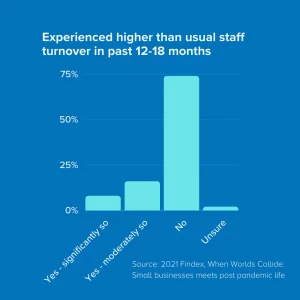
Although this data covers SMEs only, Boomer says it could equally be applied to larger businesses.
“Anecdotally, I have not noticed any different trends by size, it has been more reflective of industry and the role portability of the leavers (e.g, IT, analytics, sales, finance and recruitment are all in-demand roles for most organisations).”
Boomer says Findex’s findings reflect that there have been a lower than usual staff turnover in the preceding 12-18 months.
“We’re starting from a lower base rate than is normal,” he says.
He’s surprised that 74 per cent of respondents said they weren’t experiencing higher than usual turnover.
“I would expect more people to say ‘yes’ because we’d seen, up until the last six months, lower turnover rates for the last couple of years as people were hesitant to change jobs.”
The Great Resignation could therefore be a build-up of a few years’ worth of resignations that didn’t happen in the thick of COVID-19.
“In normal conditions, lots of people make decisions to leave their career and start their own consulting firm or their own restaurant or some other venture. They leave one industry and go to another or they stay within the same industry by starting their own business,” says Boomer.
“On net balance, we’re probably seeing the same numbers, but it’s all packed into a tighter window, so it’s much more perceptible and felt much more intensely.
“The trendline for the number of people leaving their roles has been going down, so it feels worse because we’ve been accustomed to less turnover over time. Because it’s hitting all at once, we’re not necessarily poised.”
Job-searching behaviour set to peak
The Great Resignation will arrive in Australia early this year, predicts Boomer.
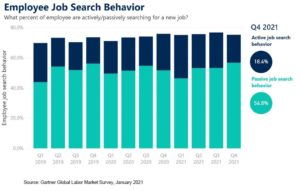
He bases this forecast on the cyclical nature of job-seeking behaviour and turnover.
For the past few years, job-seeking behaviors tend to peak in the first quarter of the year, as the above graph shows.
“Australia is a fairly passive job-seeking market. In general, about 50 per cent of employees say they engage in some sort of passive job-searching behaviour, such as updating their LinkedIn profile, responding to a recruiter who might reach out to them, or looking at job ads but not taking the time to apply for them.
“Only about 20-22 per cent of employees in most quarters engage in active job-searching behaviour, which would be applying for a role or sending out a CV. But typically in the first quarter of the year, we see 25-30 per cent of employees engaging in more active job-searching behaviour.”
“On net balance, we’re probably seeing the same numbers, but it’s all packed into a tighter window, so it’s much more perceptible and felt much more intensely.” – Robin Boomer, Director Advisory, Gartner.
Looking at 2021 alone, Boomer says passive and active job seeking has increased slightly, and confidence in job availability spiked to pre-pandemic levels.
“That’s a really strong leading indicator that people believe that it’s the time to change jobs, and that there are jobs out there if they want them.”
Will the Great Resignation only hit some industries?
It seems plausible to suggest that the Great Resignation would only impact industries that have been hardest hit by the pandemic.
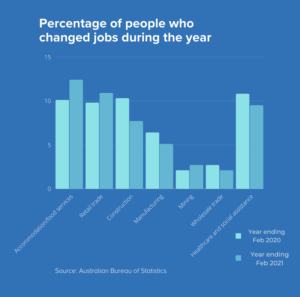
As the above chart shows, 12.4 per cent of people in accommodation and food services changed jobs in the year ending February 2021, up from 10.1 per cent in the year ending February 2020.
“You can see the industries hit hardest by it are retail and hospitality, which are obviously sectors affected in terms of their markets being disrupted. There’s no customers; there’s no work to be done,” says Boomer
Surprisingly, although employees in the healthcare and social assistance sectors have reported higher rates of burnout and experienced the emotional exhaustion and stress of working on the frontline, there was a lower percentage of them who changed jobs leading up to 2021 compared to the preceding year.
“I would say healthcare burnout is more systemic and has been going on for a longer time. It’s been brought to light more by the pandemic, but it’s not necessarily new,” says Boomer.
He also says additional external factors, such as the Royal Commission into Aged Care Quality and Safety may have resulted in a higher proportion of employees leaving aged care in 2019 and leading into 2020, leading to the finding that turnover was higher 2020 than 2021.
“In the prior year we saw something similar in the financial industry, so there may have been a similar peak in turnover.”
Despite some industries suffering a harder blow than others due to the pandemic, Boomer believes the effects of the Great Resignation will span most sectors.
“I think it will have effects across most industries, somewhat evenly.”
Is the Great Resignation playing out in your organisation? We want to hear your stories. Reach out to us via LinkedIn or leave a comment below if you’ve seen interesting trends happening in your own turnover data.
Learn how data can inform workforce predictions with AHRI’s short course, Mining Data for HR Insights.
Book in for the next session on 24 March.


Is this “Great Resignation” an illusion? It seems to be the new musak clogging up Linked In driven by recruiters, but beyond a few white-collar roles, most people I meet, just want to get back to the office and start living. I know wfh is a great top end of town thing but, hard for cleaners, security officers, drivers, retail, miners, etc etc to work from home. I think people need to look out over their charts and spreadsheets out the window.
The WFH/return to office conversation is certainly influencing me and many of my colleagues. The return to the hustle and bustle of an open plan office and a long commute is not appealing after the quiet convenience and productivity of a home office. It has certainly brought retirement planning into focus.